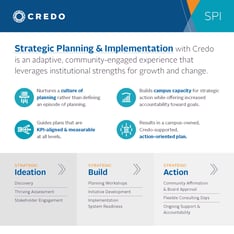
December 13 2021
What Does Your Community Know About Your Strategic Plan?
If you asked any member of your campus community about your strategic plan, would they know your vision and the things that are most important in achieving it?
In Credo’s strategy work with more than 200 colleges and universities, we’ve thought a great deal about the questions effective planning communications answer, the most meaningful modalities through which those communications are shared, and the critical planning milestones that should inform a communications timeline. Sharing your strategy in a timely, intentional way enhances your community’s understanding of the plan. Effectively communicating the what, when, and how of your plan can foster deeper levels of individual and community understanding, engagement, and ownership.
Read on to find specific ideas for framing out strategic planning communication to your campus and community.
What to Share
It’s critically important to orient your strategic planning communication around helping your campus constituents see themselves in the plan and its outcomes. When the lived experience of a faculty member, staff member, or student is visibly tethered into what they hear about the plan, their levels of buy-in and engagement are increased and more readily sustained. As you think about what to share, consider these elements and the questions they answer for your constituents:
- Rationale and expected outcomes (Why are we doing this, and what does it mean for me and my work if we succeed?)
- The process and timeline (What is going on exactly?)
- Invitations and opportunities for involvement (What is my role and how do I contribute?)
- Themes (What’s most important?)
- Data (How do we know?)
- Recognition and thanks (Who contributed, and how?)
- Connection to history/mission (Where can I anchor my understanding of the plan?)
When to Share
- When Planning is on the Horizon: Start prepping your campus community for an impending strategic planning process by celebrating successes from the current plan and planting seeds of excitement for a new plan to come. Most strategic plans in higher ed right now require significant changes to institutional culture and practice. Start building capacity for change by anchoring to institutional mission, educating your community about the realities of our industry, and keeping students in the middle of the conversation.
- When Planning Launches: When you’ve selected an external planning partner or confirmed an internal approach, launch the process with fanfare. When done well, strategic planning brings hope, excitement, and momentum to a campus —even in these tired times— and the launch offers a prime opportunity to set the tone for the work to come. The most effective launch communications utilize multiple modalities to reach varied constituents, and include clarity on when they will have an opportunity to participate in community engagements around plan ideation.
- When Data Informs the Plan: Planning is an iterative process that utilizes various qualitative and quantitative data to shape and inform an institutions’ strategic future. After constituents have offered their input, sharing thematic findings allows the community to see their ideas and confirms that they have been heard by leadership as the plan takes shape.
- When Campus Teams Build Out the Plan: A community-engaged process does not stop with ideation; engaging cross-functional groups of mid-level talent in the building of plan initiatives builds ongoing buy-in and sustainability in the implementation of the plan. From their areas of expertise, these campus “Theme Teams” help to answer the question: if these things are most important to the institution’s future, what work is required to achieve that goal? As these groups do their good work, lift them up and celebrate them in your social media, via internal communications, and through word of mouth.
- When It’s Approval Time: While the Board of Trustees will approve the plan, community affirmation of the plan is just as important. As you emerge from Board approval, consider a Community Affirmation Day that reinforces vision, strategic direction, and how the campus community will continue to be engaged as the plan comes to life.
- When the Plan is Underway: Don’t let the momentum of a powerful planning process and an exciting community affirmation process wane by allowing communication to drop off as implementation of strategic initiatives gets underway. Utilize a dynamic website hub and ongoing regular campus communication vehicles to provide ongoing updates about plan progress, celebrating wins and transparently sharing the learning that happens through doing. Consistently reinforce connection of the strategic plan work to mission and vision; err on the side of over-communication in this phase.
- When the Plan is Complete: It’s incredibly easy for a community to forget how far they’ve come. As your plan concludes, make sure you’re offering a clear picture of the growth and transformation your institution has experienced since the beginning of the plan.
Download Your Complimentary Strategic Planning & Implementation Guide
 What could a new Strategic Plan do for your campus? Download your complementary Strategic Planning & Implementation Guide to find out not only how to align your plan with action, but also what it means to have a partner along every step of the way.
What could a new Strategic Plan do for your campus? Download your complementary Strategic Planning & Implementation Guide to find out not only how to align your plan with action, but also what it means to have a partner along every step of the way.
How to Share
The range of modalities through which you communicate your planning process is broad. Here are a few of our favorites.
- Website: Some of the most effective communication plans we see on our partner campuses include a dedicated, dynamic home on their website not only for the final plan, but also for the process and timeline, updating the digital assets as the process unfolds and the plan is confirmed. You can check out some excellent examples here for Agnes Scott College in Decatur, GA; Arcadia University in Glenside, PA; and Endicott College in Beverly, MA.
- Social Sharing: Keeping a social log of milestones gives your community real-time proof of a successful plan in action. Strategic Planning community events make especially great social sharing opportunities. While large numbers of individuals from across campus disciplines and departments are gathered, take group photos of schools or classes, snap candids to share, and create social momentum around community excitement. Other milestones, even those that involve fewer people, should still be lifted up and shared publicly so the campus, constituents, and the wider community can all still be engaged with the various levels of accomplishments.
- Regular Newsletters and Leadership Communications: Many institutions include strategic planning updates in their regular weekly/monthly/quarterly communications, often focusing on recognition and next steps. In these digital and print publications, encourage your readers to follow you on social media for real-time updates about campus events and milestones; provide handles and links as applicable.
- Emails: Traditional emails highlighting the process are a necessary and basic element for ensuring the community is informed and involved.
- Print Materials: Some institutions utilize internal marketing campaigns to reinforce the plan in brochures, viewbooks, and other print materials highlighting the process, the emerging themes, and/or the overarching purpose of the effort.
- Swag: Is your vision succinct and memorable enough to be captured on branded swag? If so, the possibilities are endless. Mouse pads! T-shirts! Gifts for donors and employees! The sky's the limit.
The ultimate goal of strong strategic plan communication is to develop ongoing alignment of the entire campus community toward the institutional vision, with hope for what is possible in service of your students. Are you considering your institution’s strategic plan? What's next?
Related Blog Posts
Recent Posts
- Credo & The Constructive Dialogue Institute Announce A New Partnership For Higher Education Leadership Development March 7 2024
- Celebrating Women And Gender-Diverse Learners & Leaders February 28 2024
- Radical Self-Care For Higher Education Leaders February 21 2024
- FAFSA Strategy To Support Student Success February 19 2024
- ACA & Credo Launch National Rural Higher Education Leadership Development Partnership February 14 2024
Categories
- Strategy
- Leadership
- Student Success
- Student Success & Retention
- Enrollment
- Pivot
- Strategic Planning
- Leadership Development
- News
- Strategic Enrollment
- Campus Planning and Architecture
- Moving the Needle
- Data
- Research
- Retention
- Campus Master Planning
- Enrollment & Financial Aid
- Academic Programming
- Campus Planning
- Thriving
- Admitted Student Research
- Architecture
- Finance
- Advising
- Admissions




